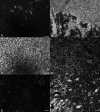Biofilm Development on Urinary Catheters Promotes the Appearance of Viable but Nonculturable Bacteria
- PMID: 33758085
- PMCID: PMC8092313
- DOI: 10.1128/mBio.03584-20
Biofilm Development on Urinary Catheters Promotes the Appearance of Viable but Nonculturable Bacteria
Abstract
Catheter-associated urinary tract infections have serious consequences, for both patients and health care resources. Much work has been carried out to develop an antimicrobial catheter. Although such developments have shown promise under laboratory conditions, none have demonstrated a clear advantage in clinical trials. Using a range of microbiological and advanced microscopy techniques, a detailed laboratory study comparing biofilm development on silicone, hydrogel latex, and silver alloy-coated hydrogel latex catheters was carried out. Biofilm development by Escherichia coli, Pseudomonas aeruginosa, and Proteus mirabilis on three commercially available catheters was tracked over time. Samples were examined with episcopic differential interference contrast (EDIC) microscopy, culture analysis, and staining techniques to quantify viable but nonculturable (VBNC) bacteria. Both qualitative and quantitative assessments found biofilms to develop rapidly on all three materials. EDIC microscopy revealed the rough surface topography of the materials. Differences between culture counts and quantification of total and dead cells demonstrated the presence of VBNC populations, where bacteria retain viability but are not metabolically active. The use of nonculture-based techniques showed the development of widespread VBNC populations. These VBNC populations were more evident on silver alloy-coated hydrogel latex catheters, indicating a bacteriostatic effect at best. The laboratory tests reported here, which detect VBNC bacteria, allow more rigorous assessment of antimicrobial catheters, explaining why there is often minimal benefit to patients.IMPORTANCE Several antimicrobial urinary catheter materials have been developed, but, although laboratory studies may show a benefit, none have significantly improved clinical outcomes. The use of poorly designed laboratory testing and lack of consideration of the impact of VBNC populations may be responsible. While the presence of VBNC populations is becoming more widely reported, there remains a lack of understanding of the clinical impact or influence of exposure to antimicrobial products. This is the first study to investigate the impact of antimicrobial surface materials and the appearance of VBNC populations. This demonstrates how improved testing is needed before clinical trials are initiated.
Keywords: biofilms; silver; urinary catheters; viable but nonculturable.
Copyright © 2021 Wilks et al.
Figures









References
Publication types
MeSH terms
Substances
LinkOut - more resources
Full Text Sources
Other Literature Sources
Molecular Biology Databases
